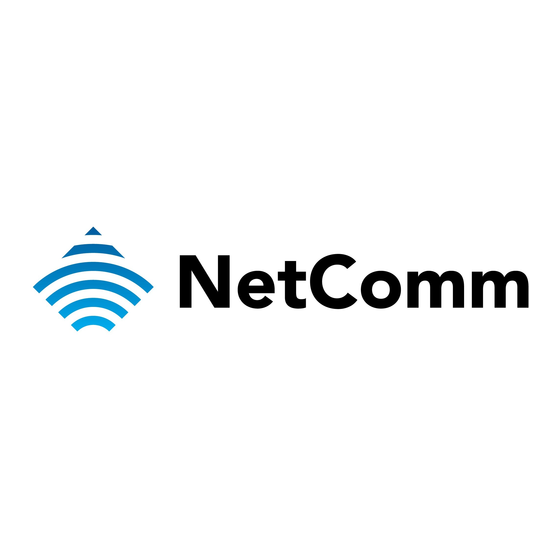Table of Contents
Advertisement
Quick Links
Advertisement
Table of Contents

Subscribe to Our Youtube Channel
Summary of Contents for NetComm Ultra Series
- Page 1 Ultra Series 54Mbps Wireless Compact USB Adapter User’s Guide...
- Page 2 REGULATORY NOTES AND STATEMENTS WIRELESS LAN, HEALTH AND AUTHORIZATION FOR USE Radio frequency electromagnetic energy is emitted from Wireless LAN devices. The energy levels of these emissions however are far much less than the electromagnetic energy emissions from wireless devices like for example mobile phones. Wireless LAN devices are safe for use frequency safety standards and recommendations.
-
Page 3: Table Of Contents
TABLE OF CONTENTS Introduction ..................1 Overview of this User’s Guide ............. 1 Unpacking and Setup ..............2 Unpacking ..................2 Software Installation ............... 3 Windows 98se/ME/2000/XP Utility and Driver Installation..3 Connecting the USB Extension Cable .......... 4 Hardware Installation..............5 LED Indicators ................ -
Page 4: Introduction
Please keep this manual for future reference. With the Ultra Series 54Mbps Wireless Compact USB Adapter, a desktop or laptop computer can communicate with another computer at a speed of up to 54Mbps per second. The Adapter provides users with an access to real-time information anywhere in their organization. -
Page 5: Unpacking And Setup
UNPACKING AND SETUP This chapter provides unpacking and setup information for the NetComm Ultra Series 54Mbps Wireless USB Adapter. Unpacking Open the box of the Adapter and carefully unpack it. The box should contain the following items: One 54Mbps Wireless LAN USB Adapter One Driver &... -
Page 6: Software Installation
SOFTWARE INSTALLATION This section will lead you to install the driver and utility of the Wireless USB 2.0 Adapter. Windows 98se/ME/2000/XP Utility and Driver Installation 1. Insert the Utility CD-ROM into your computer’s CD-ROM Drive. It will automatically run a setup menu and install the driver and the utility. For Win98se, please reboot the system to install the driver properly. -
Page 7: Connecting The Usb Extension Cable
Warning: Selecting the correct region is a legal requirement as well as a setting required for the device to operate properly. 7. When the installation is complete and the Adapter has been plugged in, you will see the following icon on the Windows task bar. When the icon is green, the device is successfully connected to the WLAN while red indicates no connection present. -
Page 8: Hardware Installation
Wireless LAN station. Wireless Utility Setting Users can configure the Ultra Series Wireless Compact USB Adapter functions with the Wireless Monitor Utility. Double-click the utility icon that appears in the taskbar. The Utility includes seven tabs: Status, Configuration, Advanced, Profile, Network, Statistics and About. - Page 9 Configuration: This screen enables configuration of Network and the Security features. Network: This function sets the Network mode, the SSID and the Channels. Network Mode: If you want to connect with an Access Point, please set to “Infrastructure” mode. If you wish to enable peer-to-peer networking between workstations, set the mode to “Ad-Hoc”.Network SSID: The SSID differentiates one Wireless LAN group name from another;...
- Page 10 WEP Encryption: Click on Enable Encryption to activate the security of the Adapter. 1. WEP-Key: WEP (Wired Equivalent Privacy) relies on a secret key that is shared between a mobile station and a base station (Access Point). 2. WEP-Passphrase: the Passphrase in the dialog box helps you to create a group of WEP key in the Key Setting.
- Page 11 Advanced: The Advanced settings adjust settings with other wireless devices. Transmit Rate: Choose one of the transmission rates: 11Mbps, 5.5Mbps, 2Mbps, 1Mbps, and Fully Automatic. Fully Automatic auto-detects the linking transfer rate and fall back when the signal is not sufficiently strong to maintain the higher rate. Power Saving: To set the Power Saving mode, select “Off”, “Normal”...
- Page 12 Profile: The Profile section allows you to set values for all parameters by selecting a previously defined profile. Type a name in the Profile Name field to create a profile, click Save and then click Apply when completed. You can click Delete if a profile is no longer used. To activate other profile, choose a profile name in the Profile Name field and click Activate.
- Page 13 Statistics: This shows real-time transmit and receive packets of the Adapter.
- Page 14 About The About section shows the Device Name, Regulatory Domain, Driver Version, MAC Address and the Utility version.
-
Page 15: Technical Specifications
TECHNICAL SPECIFICATIONS General Standards IEEE 802.11g, USB 2.0, 1.1, 1.0 Radio Technology IEEE 802.11b Direct Sequence Spread Spectrum (DSSS) IEEE 802.11g Orthogonal Frequency Division Multiplexing (OFDM) Data Transfer Rate 1, 2, 5.5, 6, 9, 11, 12, 18, 24, 36, 48, 54Mbps (auto sense) **6Mbps for 802.11g using USB 1.1, 1.0 54Mbps: Typical -72dBm @ 10% PER (Packet Error Rate) Receiver Sensitivity...

















Need help?
Do you have a question about the Ultra Series and is the answer not in the manual?
Questions and answers